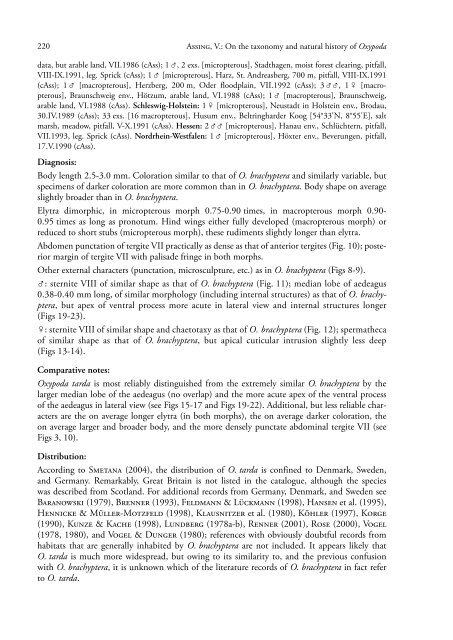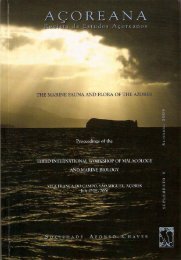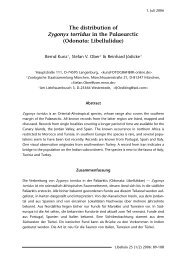On the taxonomy and natural history of Oxypoda brachyptera and O ...
On the taxonomy and natural history of Oxypoda brachyptera and O ...
On the taxonomy and natural history of Oxypoda brachyptera and O ...
Create successful ePaper yourself
Turn your PDF publications into a flip-book with our unique Google optimized e-Paper software.
220 Assing, V.: <strong>On</strong> <strong>the</strong> <strong>taxonomy</strong> <strong>and</strong> <strong>natural</strong> <strong>history</strong> <strong>of</strong> <strong>Oxypoda</strong><br />
data, but arable l<strong>and</strong>, VII.1986 (cAss); 1 , 2 exs. [micropterous], Stadthagen, moist forest clearing, pitfall,<br />
VIII-IX.1991, leg. Sprick (cAss); 1 [micropterous], Harz, St. Andreasberg, 700 m, pitfall, VIII-IX.1991<br />
(cAss); 1 [macropterous], Herzberg, 200 m, Oder floodplain, VII.1992 (cAss); 3 , 1 [macropterous],<br />
Braunschweig env., Hötzum, arable l<strong>and</strong>, VI.1988 (cAss); 1 [macropterous], Braunschweig,<br />
arable l<strong>and</strong>, VI.1988 (cAss). Schleswig-Holstein: 1 [micropterous], Neustadt in Holstein env., Brodau,<br />
30.IV.1989 (cAss); 33 exs. [16 macropterous], Husum env., Beltringharder Koog [54°33'N, 8°55'E], salt<br />
marsh, meadow, pitfall, V-X.1991 (cAss). Hessen: 2 [micropterous], Hanau env., Schlüchtern, pitfall,<br />
VII.1993, leg. Sprick (cAss). Nordrhein-Westfalen: 1 [micropterous], Höxter env., Beverungen, pitfall,<br />
17.V.1990 (cAss).<br />
Diagnosis:<br />
Body length 2.5-3.0 mm. Coloration similar to that <strong>of</strong> O. <strong>brachyptera</strong> <strong>and</strong> similarly variable, but<br />
specimens <strong>of</strong> darker coloration are more common than in O. <strong>brachyptera</strong>. Body shape on average<br />
slightly broader than in O. <strong>brachyptera</strong>.<br />
Elytra dimorphic, in micropterous morph 0.75-0.90 times, in macropterous morph 0.90-<br />
0.95 times as long as pronotum. Hind wings ei<strong>the</strong>r fully developed (macropterous morph) or<br />
reduced to short stubs (micropterous morph), <strong>the</strong>se rudiments slightly longer than elytra.<br />
Abdomen punctation <strong>of</strong> tergite VII practically as dense as that <strong>of</strong> anterior tergites (Fig. 10); posterior<br />
margin <strong>of</strong> tergite VII with palisade fringe in both morphs.<br />
O<strong>the</strong>r external characters (punctation, microsculpture, etc.) as in O. <strong>brachyptera</strong> (Figs 8-9).<br />
: sternite VIII <strong>of</strong> similar shape as that <strong>of</strong> O. <strong>brachyptera</strong> (Fig. 11); median lobe <strong>of</strong> aedeagus<br />
0.38-0.40 mm long, <strong>of</strong> similar morphology (including internal structures) as that <strong>of</strong> O. <strong>brachyptera</strong>,<br />
but apex <strong>of</strong> ventral process more acute in lateral view <strong>and</strong> internal structures longer<br />
(Figs 19-23).<br />
: sternite VIII <strong>of</strong> similar shape <strong>and</strong> chaetotaxy as that <strong>of</strong> O. <strong>brachyptera</strong> (Fig. 12); sperma<strong>the</strong>ca<br />
<strong>of</strong> similar shape as that <strong>of</strong> O. <strong>brachyptera</strong>, but apical cuticular intrusion slightly less deep<br />
(Figs 13-14).<br />
Comparative notes:<br />
<strong>Oxypoda</strong> tarda is most reliably distinguished from <strong>the</strong> extremely similar O. <strong>brachyptera</strong> by <strong>the</strong><br />
larger median lobe <strong>of</strong> <strong>the</strong> aedeagus (no overlap) <strong>and</strong> <strong>the</strong> more acute apex <strong>of</strong> <strong>the</strong> ventral process<br />
<strong>of</strong> <strong>the</strong> aedeagus in lateral view (see Figs 15-17 <strong>and</strong> Figs 19-22). Additional, but less reliable characters<br />
are <strong>the</strong> on average longer elytra (in both morphs), <strong>the</strong> on average darker coloration, <strong>the</strong><br />
on average larger <strong>and</strong> broader body, <strong>and</strong> <strong>the</strong> more densely punctate abdominal tergite VII (see<br />
Figs 3, 10).<br />
Distribution:<br />
According to Smetana (2004), <strong>the</strong> distribution <strong>of</strong> O. tarda is confined to Denmark, Sweden,<br />
<strong>and</strong> Germany. Remarkably, Great Britain is not listed in <strong>the</strong> catalogue, although <strong>the</strong> species<br />
was described from Scotl<strong>and</strong>. For additional records from Germany, Denmark, <strong>and</strong> Sweden see<br />
Baranowski (1979), Brenner (1993), Feldmann & Lückmann (1998), Hansen et al. (1995),<br />
Hennicke & Müller-Motzfeld (1998), Klausnitzer et al. (1980), Köhler (1997), Korge<br />
(1990), Kunze & Kache (1998), Lundberg (1978a-b), Renner (2001), Rose (2000), Vogel<br />
(1978, 1980), <strong>and</strong> Vogel & Dunger (1980); references with obviously doubtful records from<br />
habitats that are generally inhabited by O. <strong>brachyptera</strong> are not included. It appears likely that<br />
O. tarda is much more widespread, but owing to its similarity to, <strong>and</strong> <strong>the</strong> previous confusion<br />
with O. <strong>brachyptera</strong>, it is unknown which <strong>of</strong> <strong>the</strong> literature records <strong>of</strong> O. <strong>brachyptera</strong> in fact refer<br />
to O. tarda.
















